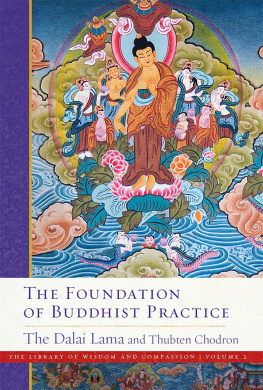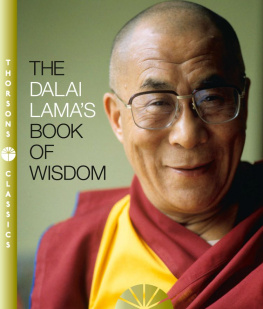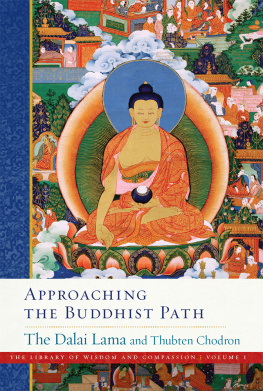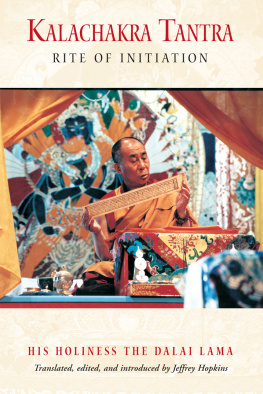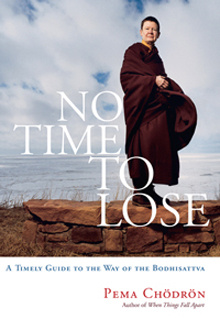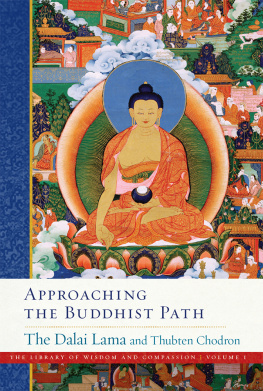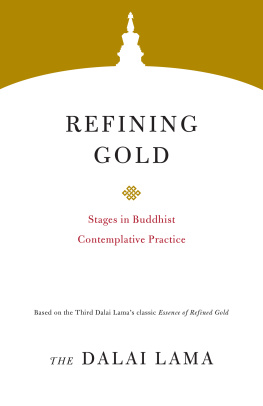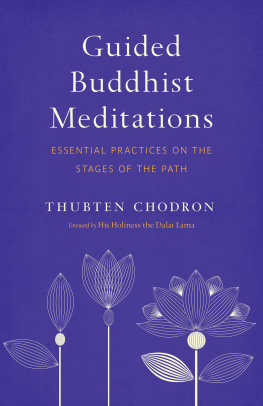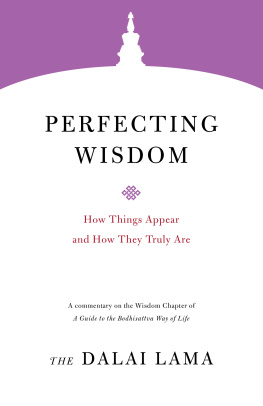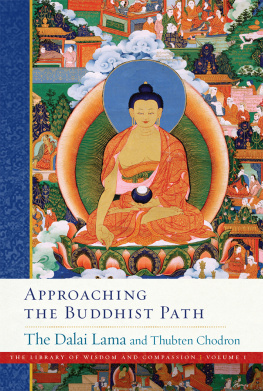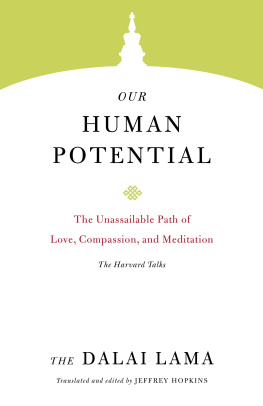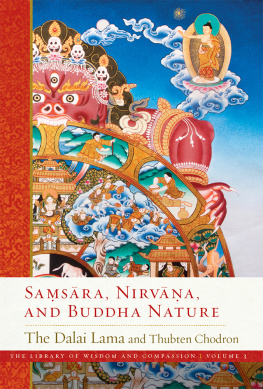THE LIBRARY OF WISDOM AND COMPASSION
The Library of Wisdom and Compassion is a special multivolume series in which His Holiness the Dalai Lama shares the Buddhas teachings on the complete path to full awakening that he himself has practiced his entire life. The topics are arranged especially for people not born in Buddhist cultures and are peppered with the Dalai Lamas unique outlook. Assisted by his long-term disciple, the American nun Thubten Chodron, the Dalai Lama sets the context for practicing the Buddhas teachings in modern times and then unveils the path of wisdom and compassion that leads to a meaningful life, a sense of personal fulfillment, and full awakening. This series is an important bridge from introductory to profound topics for those seeking an in-depth explanation from a contemporary perspective.
Volumes:
1. Approaching the Buddhist Path
2. The Foundation of Buddhist Practice
More volumes to come!

Wisdom Publications
199 Elm Street
Somerville, MA 02144 USA
wisdompubs.org
2018 Dalai Lama and Thubten Chodron
All rights reserved.
No part of this book may be reproduced in any form or by any means, electronic or mechanical, including photography, recording, or by any information storage and retrieval system or technologies now known or later developed, without permission in writing from the publisher.
Library of Congress Cataloging-in-Publication Data
Names: Bstan-dzin-rgya-mtsho, Dalai Lama XIV, 1935 author. | Thubten Chodron, 1950 author.
Title: The foundation of buddhist practice / Bhiksu Tenzin Gyatso, the Fourteenth Dalai Lama and Bhiksuni Thubten Chodron.
Description: Somerville: Wisdom Publications, 2018. | Series: The library of wisdom and compassion; volume 2 | Includes bibliographical references and index. |
Identifiers: LCCN 2017037684 (print) | LCCN 2018009580 (ebook) | ISBN 9781614295457 (ebook) | ISBN 9781614295204 (hard cover: alk. paper)
Subjects: LCSH: Buddhism China Tibet Autonomous Region. | Buddhism Doctrines. | Religious life Buddhism. | Spiritual life Buddhism. | Buddhist philosophy.
Classification: LCC BQ7604 (ebook) | LCC BQ7604 .B768 2018 (print) | DDC 294.3/420423 dc23
LC record available at https://lccn.loc.gov/2017037684
ISBN 978-1-61429-520-4 ebook ISBN 978-1-61429-545-7
22 21 20 19 18
5 4 3 2 1
Photo credits: p. xii, Kenryun Ong; pp. 50, 230, Thubten Tenzin; p. 130, Stephen Ching; p. 182, Libby Kamrowski; p. 340, Mike Novak
Cover and interior design by Gopa & Ted2, Inc.
Publishers Acknowledgment
The publisher gratefully acknowledges the generous help of the Hershey Family Foundation in sponsoring the production of this book.
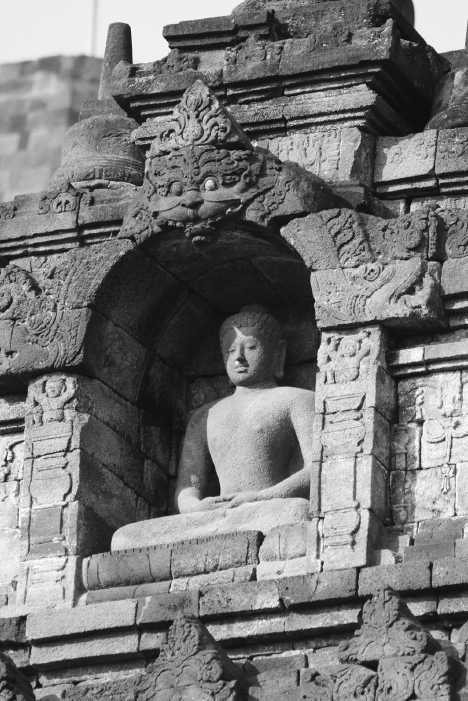
Preface
W ELCOME TO THE second volume of the Library of Wisdom and Compassion that shares His Holiness the Dalai Lamas compassionate wisdom on how to practice the path to full awakening. The first volume of the Library of Wisdom and Compassion, Approaching the Buddhist Path, principally contained introductory material that set the context for Buddhist practice. It gave us a way to approach the Buddhas teachings: to get our toes wet without diving in. This volume, which can also be read as an independent book, takes the next step and describes the foundation of Buddhist practice important topics that will help us to stay focused on what is worthwhile and to build a firm basis on which to establish a healthy Dharma practice.
As an individual who has studied and practiced the Buddhadharma since he was a small child, His Holiness the Dalai Lama is uniquely qualified to share with us what he has learned and how he implements it in his life. Occupying the office of the Dalai Lama, Bhiku Tenzin Gyatso is the spiritual leader of the Tibetan people, and until he resigned in 2011 he was also their political leader. From early on, he insisted that Tibetans develop democratic institutions in keeping with modern standards. Once the Central Tibetan Authority was established in Dharamsala, India, with functioning legislative, executive, and judicial branches, he followed his hearts yearning to retire from government service and devote his time to the Buddhas teachings. Looking back on his years as a political leader, he comments that the confluence of spiritual and political power in pre-1959 Tibet was influenced by feudalism. He relinquished the political power of the institution of the Dalai Lama in favor of a democratic government and believes that spiritual and political leadership should be distinct.
His Holiness is nonsectarian in his approach to the Dharma. He is not the leader of the Geluk tradition that position is held by the Ganden Tripa and is a seven-year appointed position accorded to a former abbot of one of the two Geluk tantric monasteries. His Holiness refers to himself as a simple Buddhist monk who follows the Nland tradition the teachings of the vibrant Buddhist monastic universities in classical India, one of which was Nland.
How the Library of Wisdom and Compassion Came About
As explained more extensively in Approaching the Buddhist Path, the first volume in the Library of Wisdom and Compassion, this series grew from the need for a presentation of traditional Buddhist teachings in a new format designed especially for people who did not grow up with knowledge of the Buddhas teachings. This audience myself included generally engages with Buddhism using a rational approach. We seek reasoned explanations and examine what we learn to see if it makes sense and is logically consistent. We try it out to see if it works before having faith or calling ourselves Buddhists.
With this in mind, in 1995 I requested His Holiness to write a short text that teachers could use for this purpose. He responded by saying that a larger commentary should be written first and, giving me transcripts of some of his talks, charged me with that task. Since I have been His Holinesss student since 1979, I also had a wealth of notes as well as English translations of many of the texts he has taught. With each new teaching I heard, more was added to the manuscript, and what began as one book quickly turned into a series of volumes. In addition, His Holiness said that he wanted this book to be unique and to include the perspectives of the Pli and Chinese Buddhist traditions.
Every few years I would meet with His Holiness for a series of interviews to ask him questions that I had accumulated from my own studies and from my friends who were also Western Buddhists. Perhaps because of cultural differences or the way society is now structured, we often have questions and qualms that require in-depth explanations that are not found in the classical Buddhist texts. His Holiness enjoyed these discussions he would often invite two or three geshes, his brother Ngari Rinpoche (Tenzin Choegyal), and the scholar and former Tibetan prime minister Samdhong Rinpoche to join us. There were serious philosophical debates and robust laughter during our sessions.
Much of the content of the two chapters on properly relating to a spiritual mentor came from these interviews as well as from gatherings of Western Buddhist teachers with His Holiness in 1993 and 1994, when we spoke frankly with him about difficulties that have arisen as Buddhism spreads in new lands. His Holiness discussed these topics openly and gave practical responses suitable for current issues.
Since the material for this series came from oral teachings, interviews, and written texts, which were translated by various interpreters who had different English translations of technical terms and different speaking and writing styles, one of my tasks as editor was to express the material in a consistent style and standardize the terms. At one point His Holiness insisted that the series be coauthored, although this was not my intent or wish. Although the series follows His Holinesss teachings, I have expanded on certain points that he covered briefly and mentioned some points that were omitted. He has been my spiritual mentor for nearly forty years, so whatever I have written has definitely been shaped by his perspective and guidance. Geshe Dorje Damdul and Geshe Dadul Namgyal also checked the manuscript.
Next page
